Pedestrian Hell in Amsterdam (10/31/03)
Last updated 12/20/03
Random thought of the day (RTOTD): I like bananas, they have a peel.
Tiny narrow
steps and other embarassing ways to die in Dam
My first thought on arriving in Amsterdam was that the Dutch must
really love tiny, narrow things. Many buildings (especially houses)
seem like they are on a diet, and could easily be the next posterchild
for
Calvin Klein. In addition, these narrow buildings come adorned with
matching teeny-tiny narrow stairs. I think these stairs would be
perfect sized for little kids, or maybe for hobbits -- actually scratch
that, hobbits had pretty big feet -- maybe they would've been a perfect
addition to ancient China, where girls had their feet bound as children
to ensure perfect doll-like little feet. Yes, these stairs would've
been welcome in any Chinese household. But when you've got feet as big
as mine (I wear either 10.5 or 11 on the US shoe scale -- they actually
have different measurement numbers across the world, in case you didn't
know), the only way to get down these kid sized stairs is walking
sideways, which gets old real
fast. Oh but the fun doesn't stop there; not only are the stairs
narrow, but they come in very large sets, making the whole staircase
apparatus pretty steep and also providing ample opportunity for a nice
long trip in case you miss a step and fall. Try climbing these stairs
with a 40lb backpack sometime -- from experience I can tell you that it
sure isn't as much fun as it sounds. You could always take the lift
(elevator in US speak), but these are about as useful as A1 Steak Sauce
in India. I think Europeans design elevators to inflict maximal
emotional trauma to all the hapless claustrophobes who can't take the
stairs for some reason. Or maybe the elevators aren't really meant to
be used? In any case, Daria and I could barely fit in the lift while
wearing our travelpacks, and we had to put our noses to the back wall
to do that. After an experience where we ended up going up 3 floors
instead of down one like we needed to (the elevator didn't have any
sign saying whether it was going up or down, it just said "lift
kommen", which I guess means "just get in and pray that this thing
takes you where you need to go" in Dutch, I decided that ordinary Dutch
people probably never use these things -- they must be some sort of
practical joke on us tourists. See
commentary to photographs of Amsterdam facades for an economic
explanation of this apparent Dutch deathwish expressed in brick and
mortar.
Yes, they
ARE
trying to kill you -- thoughts on homicidal cars, trams and bicycles
There were times during our walks in Amsterdam that I was reminded of
those ominous lyrics by Kurt Kobain: "Just because you're paranoid,
doesn't mean they're not after you". Being a pedestrian in the city,
you often get a suspicious feeling that perhaps the trams, cars and
cyclists are all conspiring to bring an abrupt, albeit painful, end to
your life. I think I've figured out how the mess of trams, buses, cars
and cyclists peacefully coexist: it's at the expense of us poor
pedestrians! After all, even the cyclists have their own special
lane, and seem to have better designed and thought-out paths than the
hapless pedestrian tourist wandering the streets of this bewildering
city. We're lucky to ever even have a sidewalk in this town, and most
such "sidewalks" are never raised, or separated from the street traffic
and tram tracks in any way. Oh yeah, and a BIG thanks to all those
people who decide to park their scooters, motorcycles and bicycles on
the already-narrow sidewalks, making them virtually nonexistent.
Furthermore, the sidewalks often pass
through roads with cars coming at you from your side, but since they
aren't raised, you have no way of knowing that you're entering a road.
In addition, such roads never have any traffic lights or crosswalks, so
unless you're on your toes, you could take a step into the road and
have cars honking at you, or cyclists ringing their silly little bells
before trying to run you down. It's a rough world out there... the
scariest part for me was the existence of many streets, like
Leidsestraat, which have tram lines running straight through the middle
of the street, just a few feet away from yours truly; one wrong step,
or a little stumble, and you could find yourself underneath the Number
5 tram, which will happily proceed on its merry way to the Central
Station. The best part is that no one cares about any crosswalk signs
(I think they're just road decorations throughout much of Europe), so
if you want to cross the road you need a little bit of courage and a
lot of luck to just step out into the street and hope that people will
stop for you. Or you could always wait an hour till the traffic stops.
The choice is yours.
So Why would
you EVER go there?
As Spike Lee said in that Nike commercial with Michael Jordan: "It's
gotta be the shoes!" If you've
Those Dutch shoes are sooo darn cute!
Pictures
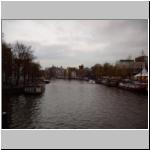
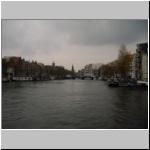
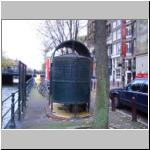 Canals
and bridges
Canals
and bridges
Amsterdam has plenty of canals... and some of them offer
you a place to go to if nature calls, at least if you're a guy... Canals are, as one would expect, often
intersected by bridges, lots of bridges, so many that there is even a
place known as "the Bridge of 15 Bridges" because that's the number you
can supposedly see from that point (we counted only 8 when standing
there, but maybe the Dutch eye sees farther). Nearly all bridges can be
opened to allow the passage of boats, and the hours of opening/closing
the bridges are not fixed, like they are in some other cities of much
water (St.Petersburg opens all its bridges over Neva river, in rapid
succession, shortly after midnight and puts them back together around
4am, so you can get caught on an island overnight if you aren't
careful). In Amsterdam bridges are manned and opened as needed. We
observed the opening event on a small bridge which stopped bike traffic
across for a good 10 minutes, after which time the operator announced
that the bridge got broken and will not be put together again for some
time, and would everyone please take a detour via a different bridge --
choose any one, there's such a whole lot.
One other cool thing about all the canals is that they have
plenty of houseboats on them. It's pretty cool to walk through the
actual downtown sections and see houseboats moored on embankments. They
even have a Houseboat Museum which promises to show you "a snugly
furnished, traditional Amsterdam houseboat".
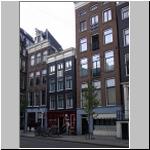
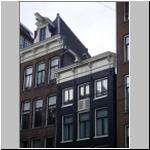
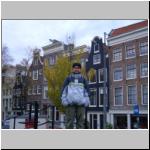 Architectural
quirks of Amsterdam
Architectural
quirks of Amsterdam
The architecture in Amsterdam is quite interesting (and
somewhat dangerous). Due to historic zoning regulations, old
houses were generally built quite narrow and tall. The reason behind the zoning regulation
and the relevant tax law is unclear, but the consequences are
economically sound: because Dutch homeowners historically had to pay
property tax based on either land footprint of the house, or the width
of the facade (not clear which of the two, but definitely not total
living space), they built high and narrow. A typical house in Amsterdam
is 2-3 windows wide yet 4 stories tall, facing a canal, and decorated
with a lovely triangular topper, for the reasons yet to be explained.
The staircases in
these buildings tend to be navy-style
small (as in narrow and with
short steps) and steep to take up little space.
If your house is one-room-wide
already (but has 3 or 4 such rooms stacked on top of each other), you
cannot really afford to take up half of that space with a royally
expansive, wheelchair-accessible staircase, now can you? Economics made
Dutch houses look like they've been squished from both sides, and
economics endowed them with break-a-neck staircases. It's hard
enough for a person to make it up these stairs with luggage,
much less furniture. Elevators
were a later addition, and keeping in the tradition of tight spaces,
they are certainly not adequate for moving anything wider than a lean
person. Consequently, they've got these hooks at the top
of buildings, and all windows are easily removable to allow furniture
hoisted using these hooks to be moved into the appropriate room through
the window. This is how Amsterdam
got its lovely skyline of triangular toppers, installed not for their
cuteness value but for the sheer utility of having a place on top of
the house where to attach the hook with pulleys.
To ensure survival of glass windows and paint on the facade during such
an uplifting event as bringing a piano into a 4th-floor apartment, most
houses lean forward at a barely perceptible angle; you really only
notice it when an adjacent facade does NOT lean, so you can see the
difference, like in the pictures above. By the way, most buildings in
the city are indeed adjacent. The Dutch do not believe in leaving open
space between houses, probably due to the aforementioned property laws,
hence any building can only be entered from its facade side, which will
inevitably face a canal. At least they reconciled themselves to the
concept of traffic-accessible streets along embankments, so people can
walk/bike/drive in front of those canal-facing houses instead of
relying exclusively on boat transportation, like in Venice.
Neat, huh? Actually the tiny stairs sound a lot cooler than
they really are... it gets old having to walk sideways up or down the
stairs all the time.


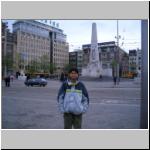
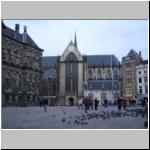
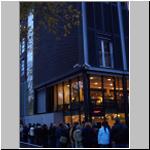
 Some famous sights around Amsterdam.
Some famous sights around Amsterdam.
Van
Gogh Museum
The pictures do not include Van
Gogh Museum because its building is rather bland on the outside, and
photography is prohibited inside, but the place certainly deserves a
few words as one of the "famous sights". It houses over 200 paintings
by Van Gogh, including his early "Potato eaters" and late-term
landscapes of "Wheatfield with <something>" series. This
collection opened our eyes to the fact that we love Van Gogh, mostly
for his technique of making select objects in the painting seem alive
and 3-D, literally jumping out at you off the canvas (Puneet's
obsession), and the choice of bright, saturated colors (Daria's
darling). We also discovered a lot about the painter's life, including
details that I could even do without, like the incident of Vincent's
cutting off his own earlobe during a fit of mental illness, or his
suicide. The commentary on certain art works was most helpful, and I
now have some idea of how Van Gogh does or does not fit into the
impressionist art movement. Still, when we get back home, we'll be
adding that art history book or two to our library -- just to have more
of a clue. By the way, the most amusing item in the exhibition, in its
"learn more on your own" section, was a book about Van Gogh's life and
work, written for very young audience (pre- and primary school, I
imagine) from the viewpoint of Vincent's brother Theo. The book
faithfully attempted to explain everything, not to the exclusion of the
sad episode with the ear, and I applaud its courage but reserve my own
judgement as to when to introduce little kids to Van Gogh. Myself, it
took 25 years to come to appreciate his art... but maybe it's different
if you start trying early.
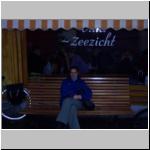
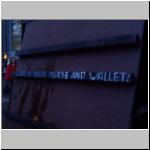
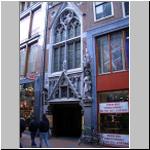
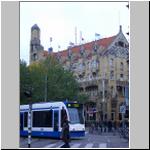

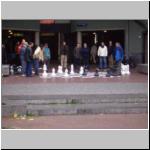 Some sights you probably won't find in tourist books.
Amsterdam is full of tons of wacky stuff, all you gotta do is look.
Some sights you probably won't find in tourist books.
Amsterdam is full of tons of wacky stuff, all you gotta do is look.




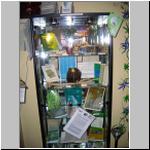
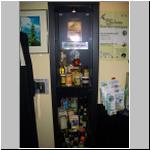 Dam Entertainment
Dam Entertainment
Amsterdam has a very strong cannabis culture. It is legal to consume cannabis
products (weed, hash) in the privacy of your home or in specifically
designated smoking bars known as "coffee shops" (if you simply want
coffee, you go to a "cafe" instead). It is also legal to possess up to
5 grams of grass on your person. Posession of a larger amount of
marijuana (yet another name for cannabis), or of harder drugs, or
marijuana use in public places, will land you in trouble just like in
any other country -- hefty fine or jail sentence, depending on the
severity of offense. So no, Amsterdam is not the drug addict's heaven,
but certainly a nice vacation spot for anyone who regards cannabis as a
recreational drug on par with alcohol.
We wandered
by Cannabis College on our trip to the red-light district (out of
respect for privacy, no pictures of that area). This place actively
encourages photography and has a very helpful staff that's willing to
answer any and all cannabis-related questions you may have. Did you
know that the lights used to grow the plants indoors uses the same
amount of electricity as a washing machine -- and they need to be run
for half the day (12 hours)? Did
you know that marijuana drug (i.e. the part of the plant that contains
THC, the chemical that affects the brain in a manner pleasing to
humans) comes only from female plants, and when you first plant the
seed, you don't know if it's male or female (50/50 chance), so in a few
weeks you weed out the male plants?
Leidseplein is the best nightlife
spot in all of Amsterdam: the square itself houses a number of pubs, a
coffee shop ("The Bulldog" with its police-state theme is the oldest
such establishment in town), a comedy show theater ("Boom Chicago", an
improvisation-based stand-up comedian act with a cast of five, in
English, highly recommended by such esteemed reviewers as the Mehras),
a drama theater, two grand cafes (Parisian-style large
cafe/bar/restaurant establishments with floor-to-ceiling glass windows
and plush decor, may be somewhat reminiscent of a U.S. Denny's or IHOP,
not to be confused with "brown cafes" of Amsterdam which are small,
dark, intimate, pub-like places), and all around the square is more of
the same plus tons of restaurants. If you come to Dam to party and stay
in Leidseplein area, you need never leave it until your departure,
because everything you need (including laundry facilities and Internet
access) can be found right here in the space of 5 blocks.
A word on the red-light district:
yes, it exists, and the girls do sit in the first-floor shop windows.
However, a visitor who comes to the area for a free show will be
disappointed, because the ladies are wearing more clothes than you
would see on a public beach. We cannot testify to the quality of paid
services for the lack of such experience, or want thereof; we only know
that the services are safe and legal, since entertainment guides to
Amsterdam include a section on rules of behavior in the red-light
district, composed by the city police.


 Canals
and bridges
Canals
and bridges

 Canals
and bridges
Canals
and bridges

 Architectural
quirks of Amsterdam
Architectural
quirks of Amsterdam




 Some famous sights around Amsterdam.
Some famous sights around Amsterdam. 




 Some sights you probably won't find in tourist books.
Amsterdam is full of tons of wacky stuff, all you gotta do is look.
Some sights you probably won't find in tourist books.
Amsterdam is full of tons of wacky stuff, all you gotta do is look.




 Dam Entertainment
Dam Entertainment